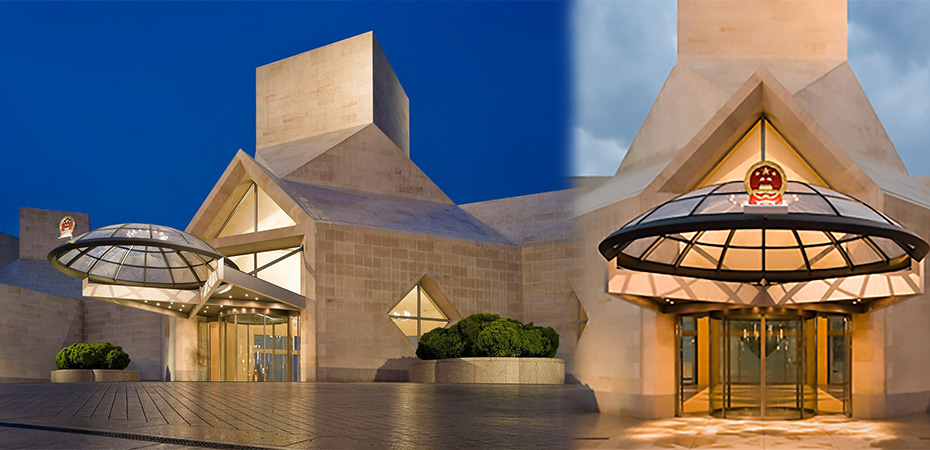What Are You Looking For?
Why Is Limestone the "Life Stone" of Architecture and Interior Design?
Aug 11, 2025Limestone, often referred to as "Life Stone", is one of nature's most fascinating geological gifts to architecture and interior design. Formed over hundreds of millions of years from the fossilized remains of marine organisms, this sedimentary rock has graced iconic structures like the Louvre's east façade, the Chinese Embassy in Washington D.C., and luxury boutiques such as Louis Vuitton's flagship stores. Its unique blend of durability, aesthetic versatility, and historical resonance makes it a favorite among architects like I.M. Pei.
This blog explores limestone's geological origins, types, properties, applications, and market considerations, offering designers and architects actionable insights for specifying this material.

1. Geological Formation: A Journey Through Time
Limestone is a sedimentary rock primarily composed of calcium carbonate (CaCO₃), formed through the accumulation of marine fossils, shells, coral, and algae, compressed over eons. The distinctive veining and color variations result from mineral impurities like iron oxides, clay, or silica and pressure conditions during formation.
Key stages in limestone formation:
• Biogenic Accumulation: Marine organisms' skeletal fragments settle on ocean floors.
• Lithification: Over millions of years, these deposits undergo compaction and cementation.
• Tectonic Uplift: Plate movements expose limestone deposits for quarrying.
This process creates a material that embodies both geological history and functional resilience.

2. Classification: Color and Texture Varieties
By Color:
• White Limestone: Pure, bright, ideal for minimalist designs, e.g., French Pierre de Bourgogne.
• Grey Limestone: Neutral tones for contemporary projects.
• Beige / Yellow Limestone: Warm hues like Jura Beige from Germany.
• Brown / Red Limestone: Rich, earthy tones with iron oxide influences.
By Surface Finish:
• Honed / Matte: Non-reflective, smooth finish for interiors.
• Bush-Hammered: Textured, slip-resistant for exteriors.
• Brushed: Subtle texture highlighting natural grain.
3. Technical Properties: Strengths and Limitations
Advantages:
• Sustainability: Zero VOC emissions, 100% recyclable.
• Thermal Mass: Absorbs and slowly releases heat, improving energy efficiency with thermal conductivity: ~2.5 W/m·K.
• Aesthetic Flexibility: Available in slabs up to 3m in length, though often smaller due to natural fissures.
Challenges:
• Porosity: Water absorption rates of 0.5–5% require sealants, e.g., fluoropolymer coatings for wet areas.
• Flexural Strength: Lower than granite, ~10 MPa vs. 20 MPa, making it prone to cracking under impact.
• Maintenance: Susceptible to acid etching, pH <7; regular sealing recommended.

4. Architectural Applications: Case Studies
Exterior Cladding:
• Louvre East Façade: French limestone's durability withstands Paris' temperate climate, annual rainfall: 650mm.
• Chinese Embassy, Washington D.C.: I.M. Pei's design combines limestone's grandeur with Chinese architectural motifs.
Interior Design:
• Feature Walls: Limestone's acoustic absorption, NRC: 0.05–0.1, benefits open-plan spaces.
• Flooring: Bush-hammered finishes enhance slip resistance, COF >0.6 for ADA compliance.
Pro Tip: Avoid high-traffic kitchen applications due to staining risks from oils and acids.

5. Market Overview: Pricing and Sourcing
Global limestone prices range from 20–60/sq.ft., influenced by:
• Thickness: 2cm for interiors vs. 3cm for exteriors.
• Origin: French Lutetian limestone commands premiums for its homogeneity.
• Finish: Polished surfaces add 15–20% to base costs.
Recommended Suppliers:
• Europe: Rocamat (France), Levantina (Spain), Antolini (Italy)
• North America: Indiana Limestone Company
• Asia: Stonelink (China)
Designer Note: Request ASTM C568/C97 test reports for compressive strength (>28 MPa) and absorption rates.
Why Specify Limestone?
Limestone offers a rare convergence of narrative depth and functional performance. Its carbon-neutral lifecycle with 0.079 kg CO₂/kg embodied carbon aligns with sustainable design goals, while its patina develops character over time, a testament to the "Life Stone" moniker. For projects demanding materials with geological heritage and design flexibility, limestone remains unparalleled.